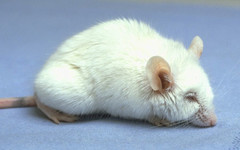Pain associated behaviour
We generally differentiate between acute pain and chronic pain. Acute pain (post-surgery or disease-related) is often characterized by a number of behavioural changes, such as aggression, isolation in the group, restlessness and self-mutilation, as well as by autonomic reactions such as dilated pupils and rapid breathing.
Chronic pain
With chronic pain, such as seen with tumors, notable effects may be poor overall condition, piloerection, social isolation and a hunched posture. The animals will lose weight and are less active. Diseased mice tend to take in little water, which will lead to rapid dehydration (see picture).
Pica- behaviour
When mice are in either acute or chronic pain, they may start to engage in pica-behaviour, which is defined as eating bedding material or other strange, non-food objects (see movies).



